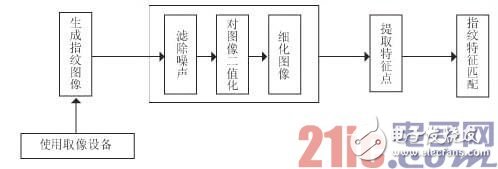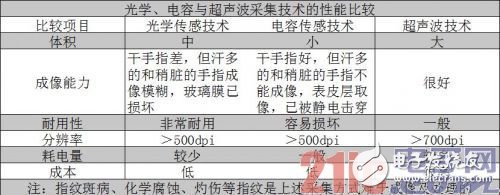Although fingerprint recognition technology has entered the civilian field, its working principle is actually quite complicated. Unlike manual processing, biometric technology companies do not directly store fingerprint images. Over the years, various biometric technology companies and their research institutes have studied many fingerprint recognition algorithms (the relevant laws of the United States believe that fingerprint images are personal privacy, so fingerprint images cannot be stored directly). But various recognition algorithms ultimately boil down to finding and comparing fingerprint features on fingerprint images. This is the basic principle of fingerprint recognition technology, which is to collect fingerprint images and compare fingerprint features. In a general sense, two types of fingerprint characteristics can be defined for fingerprint verification: overall characteristics and local characteristics. The overall characteristics are those that can be directly observed with the human eye. it includes: 1. Basic pattern Common fingerprint patterns include ring, bow, and spiral patterns. Other fingerprint patterns are based on these three basic patterns. It is just a rough classification. It is not enough to distinguish fingerprints by pattern type alone, but classification can be more important. It is convenient to search for fingerprints in large databases. 2. Pattern Area The pattern area is the area that contains the pattern features, that is, it can be distinguished from the pattern area which type the fingerprint belongs to. 3. Core Point The core point is located at the progressive center of the fingerprint lines, and it is used as a reference point for fingerprint reading and fingerprint matching. 4. The triangle point (Delta) The triangular point is located at the first bifurcation point or break point from the core point, or the converging point, isolated point, turning point of two striped roads, or pointing to these singular points. The triangular point provides the starting point for counting and tracking fingerprint lines. 5. Type Lines The pattern line is a cross pattern that appears at the place where the pattern line of the fingerprint encircling the pattern area starts to be parallel. The pattern line is usually short and interrupted, but its outer line begins to extend continuously. 6. Ridge Count The number of patterns refers to the number of fingerprint patterns in the pattern area. When calculating the number of fingerprints, generally connect the core point and the triangle point first, and the number of intersections of this line with the fingerprint line can be regarded as the number of fingerprints. Local features refer to nodes on the fingerprint. Two fingerprints often have the same overall characteristics, but their local characteristics cannot be exactly the same. The local feature points have the following types: 1) Node: Fingerprint lines are not continuous, smooth and straight, but often interrupted, bifurcated or bent. These breakpoints, bifurcation points, and turning points are called "nodes." It is these nodes that provide confirmation of the uniqueness of the fingerprint. 2) End point: the place where a stripe line ends; 3) Bifurcation point: the place where a stripe line splits into two; 4) Center point: the geometric center of the fingerprint, which is the place where the lines produce the greatest curvature; 5) Triangular point: where the lines of three different directions converge; 6) Cross: the place where two stripe lines cross; 7) Small island: a very short line; 8) Sweat gland hole: the small hole on the ridge line is the sweat gland. These characteristics are used to distinguish different fingerprints. among them: 1. End points and bifurcation points are the most commonly used features. The usual algorithms must record their position and direction. 2. The center point and triangle point are commonly used in criminal investigation systems, but are not commonly used in civil systems. Because the collectors used in these applications are often small in area, it is difficult to collect the center point and the triangle point completely. 3. Intersections and small islands are often not used in actual systems due to computational difficulties. 4. Someone once proposed to use sweat gland holes for fingerprint identification, but this method requires fingerprint collection equipment to have a very high resolution. So it is not used in the actual system. Fingerprint recognition consists of two processes, namely the registration process and the recognition process. The principle is shown in Figure 1: Figure 1 The process of fingerprint recognition In the registration process, the user needs to collect fingerprints first, and then the computer system will automatically perform feature extraction, and the extracted features will be stored in the database or other designated places as a template. In the identification or verification stage, the user first collects fingerprints, then the system automatically compares the fingerprint library templates, and then gives the comparison results. On many occasions, the user may also need to enter some other auxiliary information to help the system match, such as account number, user name, etc. This process is a general process, applicable to all biometric identification technologies. There are currently three types of fingerprint collection devices commonly used in the market: optical, silicon chip, and ultrasonic. The performance comparison of these three forms of acquisition technology is shown in Table 1: Table 1 Performance comparison of optical, capacitive and ultrasonic acquisition technology 1. Optical The optical fingerprint collector is the earliest fingerprint collector and the most commonly used at present. It has the following advantages: 1 It has been used for the longest time and has withstood the test of actual use; 2 Good adaptability to environmental factors such as temperature; 3 The price is relatively low and the resolution is high, which can reach more than 500 dpi. At present, there have also been collectors that replace the prism and lens system with a grating lens, and the photoelectric conversion CCD device has also been replaced with a CMOS imaging device, thereby omitting the image acquisition card and directly obtaining digital images. 2. Silicon chip type Silicon chip fingerprint collectors appeared in the late 1990s. Most silicon chips measure the DC capacitance field between the surface of the finger and the chip surface. This capacitance field is converted into a grayscale digital image after A/D conversion. 3. Ultrasonic Ultrasonic fingerprint collector may be the most accurate fingerprint collector, but it is currently immature and has not yet been applied on a large scale. Engine Parts oil tube,Engine Parts water pipe,Engine Parts exhaust pipe,Engine Parts Rubber Pipe Chongqing LDJM Engine Parts Center , http://www.ckcummins.com
